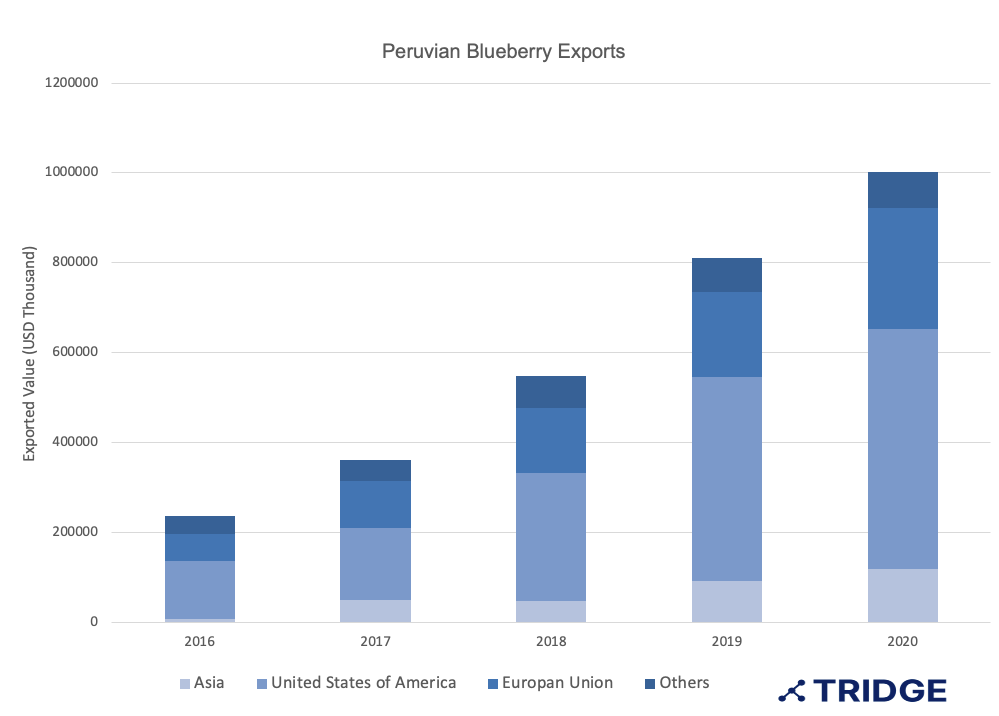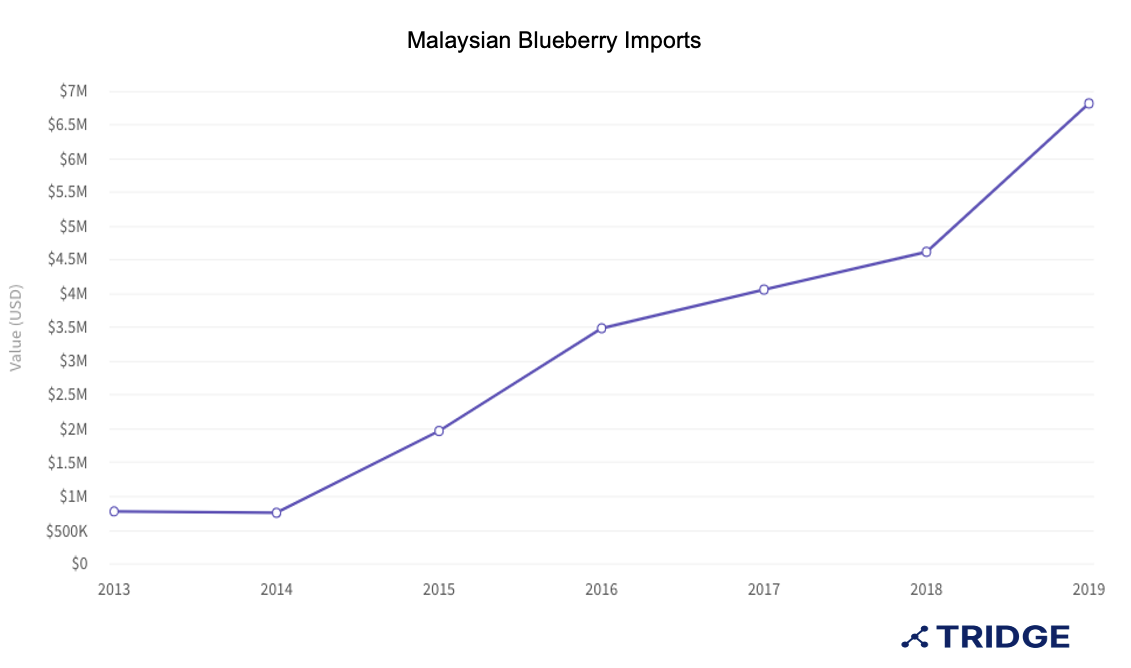Malaysia: New Market for Peruvian Blueberries

Asian Market Expansion Strategy
The development strategy for Peruvian blueberries is to continue to open new markets and position blueberries as a high-quality product. Within this strategy, the Asian market is key to keep increasing their export volume year after year. According to ProArandos (Peruvian Blueberry Promotional Association), blueberry exports will increase by 30% this season compared to the previous season, from 162,459 tonnes to 211,200 tonnes. The interest in the Asian region occurs in the context in which Chile faces problems with its production, and it is anticipated that there will be issues to supply these markets.

Source: ITC Trade Map, Tridge
So far, for Peru, the Asian market has had a substantial growth over the last few years, where blueberries have found an accelerated growth in different markets. Since the opening of the Chinese market in 2017, exports to China now account for USD 112 million at 16,000 tonnes. ProArandos expects that exports to China will increase by 111% in volume to reach around 34,000 tonnes by the end of the current season.
Other significant markets in Asia where imports of Peruvian blueberries have increased at a fast pace are Singapore and Thailand. Singapore had a 146% increase in Peru’s export value in 2020 from 2019 and exported a record value of USD 2.8 million. As for Thailand, Peruvian imports have been consistently growing over the last couple of years, with a 43% increase in quantity since 2016. In 2020, Thailand imported USD 1.98 million in value, the highest import value recorded. The goal is to reach more markets in Asia, such as Korea, Indonesia, Japan, and Vietnam, where phytosanitary protocols are being reviewed for authorization.
A Promising Malaysian Market
Although the Malaysian import market for blueberries remains small, it has had substantial growth within the last few years and is expected to grow in double-digits. Blueberry imports had a 10% growth in 2020 from the previous year and have increased a 28% growth rate since 2016. As a result, last year’s imported value reached USD 7 million and was the highest value recorded so far. The consumption of fruit in Malaysia follows the rising trend seen for the rest of the region. According to the USDA, blueberry consumption in Asia will reach 50,000 tonnes by 2024.

Source: ITC Trade Map, Tridge
The leading supplier for blueberries to Malaysia is South Africa, which accounts for 41.5% of the import share. The second supplier would be the US with 3.5% of the share; however, the US had a 3% decline in exports to Malaysia in 2020 from the previous year. Chile follows as the third-largest supplier with 10.3% of the share. However, a shortage of Chilean blueberries is expected for the current season due to reported production falls.
Outlook for Peruvian Blueberries in Asia
There is no doubt this will be a record-breaking year for Peruvian Blueberries. The 30% increase in exported volume this season that ProArandanos has forecasted doesn’t seem to be far from reality, especially with the opening of new markets such as Malaysia. However, for the Peruvian products to succeed in the different Asian markets they aim to penetrate, there will be logistics challenges to face as these are all distant markets requiring long transportation times. Furthermore, for the case of Malaysia, all shipments of blueberries must come from certified fields, have been processed in authorized balers, and must undergo cold treatment before being sent.
Although the Malaysian market can’t be compared to the Chinese one in terms of volume, it might represent a significant share of the exports in Asia. Peruvian blueberries will likely take a large part of the share this season that today belongs to the US and Chile as they will be able to supply the market in time. In the long term, gaining a substantial share in the Malaysian market could be essential to the development of the product in the region.
Sources:
- El Peruano. "Perú iniciará envío de arándanos a Malasia".
- Fresh Plaza. "Malasia abre su mercado a los arándanos peruanos."
- Fruitnet. "Peruvian blueberries increase access."
- Portal Fruticola. "Envíos de arándanos peruanos a Malasia comenzarán este año."





